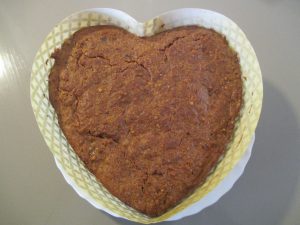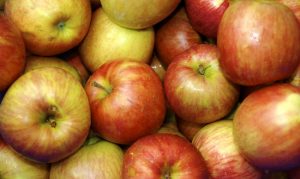Yummm … another successfully completed sugar free recipe. I measure the success rate of my culinary exploits (yes yes) by the percentage of satisfaction under my roof. For the banana cake detailed below, we are 100%, yes yes!
Ingredients to Put in Place
In theory, for 8 people, but it depends on which person we’re talking about. A small person will eat less, although they will throw more on the ground (especially a very small person) so in the end maybe it’s basically the same.
- 2 ripe bananas
- 150 g of crushed walnuts
- 3 eggs
- 250g of flour
- 120 g of applesauce. We steam the apples and make compote out of it, then use it in the recipe.
- 150 g of melted butter
- 1 teaspoon vanilla
- 1 teaspoon baking powder
Recipe as such
1. Preheat the oven to 180 ° C.
2. Cut the bananas into small cubes. If you have ever tried cutting bananas into small cubes, you will find that it is not easy. With your fingers (and a knife), bananas stick together so you have the option of doing it with a fork, but it’s not practical. So no need to worry if in the end you don’t have perfect little cubes. I know
 some of our readers are very keen on accuracy in our recipes, I do the best I can to please at that level but this is not Ricardo’s cooking site.
some of our readers are very keen on accuracy in our recipes, I do the best I can to please at that level but this is not Ricardo’s cooking site.
3. Beat the eggs with the applesauce, liquid vanilla and melted butter in a bowl.
4. Add the flour and baking powder and mix well.
5. Add the nuts and bananas, stir well.
6. Butter a cake tin. We found one in the shape of a heart, because we love you very much. See picture .
7. Pour in the preparation.
8. Bake the cake for 45 minutes.
9. Leave to cool when removing from the oven.
10. Unmould.
11. Enjoy cold. Lukewarm is good too. I repeat for the benefit of our readers / visitors: nothing is perfect in this world, and certainly not my blog recipes for the AMCC! If you don’t put in the exact amounts, or if you leave the cake in the oven a little longer, there is no reason to feel guilty. In our school, we advocate acceptance and joy of living 🙂
That being said, I took it upon myself to improve myself in the measurements to obtain as much accuracy as possible (while keeping my joie de vivre) and I even bought a measuring cup, which I didn’t had not before! To tell you how far I went there in my approximations. Yet it still came out good! Now it comes out almost excellent. As you see, we never stop learning and improving.
Food Benefits
I take this opportunity to make a small section of the benefits in terms of Vitamins / Minerals of this beautiful little recipe:
Bananas
A medium sized banana contains 0.4mg of vitamin B6 (all infos here are taken from our course 142 Nutritional Balance).It also contains 422 mg of potassium. This is almost 10% of the daily amount needed for an adult (4700 mg). That’s just with one ordinary banana! You should know that consuming coffee, alcohol or stress (in a pill!) prevents the normal absorption of potassium (and most nutrients for that matter).
Bananas also contain fluorine (difficult to quantify) as do oranges, apples and apricots (fruit category). Here is what is mentioned in our courses: “The recommended daily intake of fluoride remains an open topic. It is better to observe the situation from afar and not participate in the endless controversies.” Pearls of wisdom.
Bananas are recommended for the following conditions:
- abscess
- albuminuria (the presence of albumin in the urine)
- constipation
- fever. Of course, you won’t stop a fever by only eating bananas, there are better ways, such as the cold compress.
Nuts
Nuts are good. They are a source of copper (Cu) (like.. mushrooms, brown rice or seaweed.). Nuts also contain magnesium (Mg), which is essential for the proper metabolism of calcium. It is said that magnesium + calcium = dynamism + energy Did you know? Nuts contain all sorts of good things, also sulfur (S), to help detoxify the liver. Sulfur supplements are recommended in cases of chronic bronchitis, asthma and allergies, as they purify the respiratory system. At the orthomolecular level, we like nuts because of alanine, creatine, arginine, gluthatione, glycine, histidine, leucine, ornithine, proline, serine and threonine.
And you thought you were going to read a simple cake recipe …
Eggs
In eggs, we find MSM, a good thing despite the shady name … in fact MSM, as a sulfur element, keeps our immune system operational in eliminating toxins.
Eggs also contain a type of essential fatty acid (linoleic acid), proud member of the omega 6 family. There’s iron in eggs but it is absorbed at a rate of only 10% (maximum) while in meat and fish is more like 25%. Better than nothing you’ll tell me.
We also find in eggs: fluorine (helps teeth and bones), copper (Cu), a little manganese (Mn), selenium, etc. Those are ingredients that are present naturally, that we don’t need to add and gives us life: what a gift!
Eggs are especially recommended in the following cases:
- albuminuria
- arteritis (when the artery wall is inflamed)
- arthritis
- back pain
- cirrhosis
- bedwetting
- fever
- spasmophilia
In terms of glues and crystals, you know, the toxic excretions, eggs produce crystals (like let’s say meat or dairy, also full of proteins).
Apples
The consumption of apples is always suggested as in “an apple a day keeps the doctor away”. But, in case of diabetes or hypoglycemia, when we follow a hypoallergenic diet, apples are part of it, as well as rice, carrots, pears and olive oil. 
Because they contain fibers, it can tackle high-cholesterol problems. And more subtly, if you have putrefaction problems in your digestive systems, apples can help with that, too.
It is a natural source of aluminum. That’s not a bad thing because aluminum, as a trace element, regulates and calms the brain. It is essential for the proper functioning of the nervous system and is most recommended for children who have difficulty concentrating in school, as well as for those under stress due to a busy schedule. Its deficiency can lead to poor concentration, insomnia as well as poor school performance. So don’t skimp on the apples, and make that two apples a day!
Finally it also contain fluoride, as do most of the elements in this banana cake recipe. Did you notice, nuts, bananas and apples all contain fluoride. That makes this recipe a perfect Fluoride Cake Recipe – no need to brush your teeth!
Seriously, because there’s no sugar…
Happy cooking,
——
If you enjoyed this article, maybe you’ll also like:
Macadamia: No-Sugar Cookie Recipe




Leave a Reply